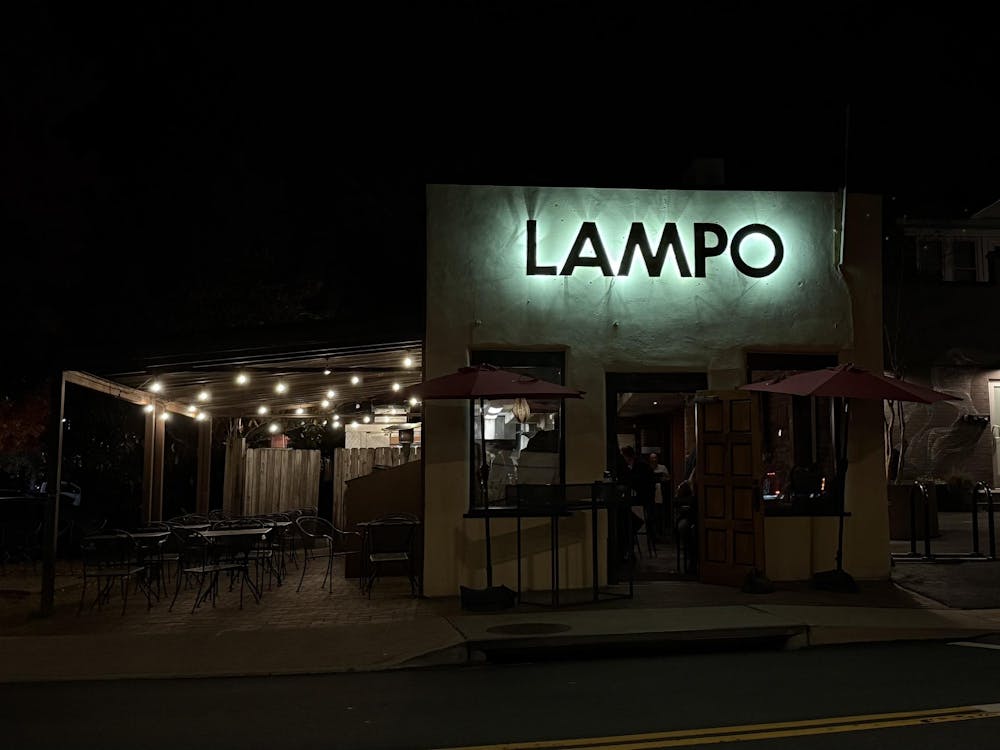It has been the dining place for the Queen of England and once boasted a cow on its roof. Sitting majestically at the top of the Lawn, it is an architectural icon as well as home base for University streakers.
Since 1826, the University's Rotunda has burnt down, been rebuilt, torn down and built up again. In all, there have been three different Rotundas. Yet it still serves as a University symbol, the centerpiece for Jefferson's Academical Village and a rich source of University history and culture.
Sandy Gilliam, secretary to the University's Board of Visitors, has many fond Rotunda memories. As a child, he recalls visiting his grandmother's Charlottesville home and traveling down Rugby Road to the Rotunda, where he and other children would play on the Rotunda staircases.
Later, as a University student living on the Lawn, Gilliam remembers study breaks around 11 o'clock each night. At the time, the Rotunda's first floor - where there were soda machines, telephones and bathrooms available for student use - was left unlocked. Gilliam said regardless of the weather, he would get a Coke from the soda machine and sit on the steps of the Rotunda, drinking, and taking time to "contemplate the eternal beauty of the purple shadows on the Lawn."
He said he is shocked when he discovers a student who goes through four years without setting foot in the Rotunda.
"It upsets me," he said. "It's Jefferson's centerpiece."
The original Rotunda, a half-scale version of Rome's Pantheon, was the last piece of the Academical Village to be completed. Before the days of Alderman, Clark and Clemons libraries, the Rotunda's Dome Room served as the University library, while classroom space occupied the rest of the Rotunda.
In 1853, however, architect Robert Mills, who also designed the Washington Monument, added an annex to the Rotunda's north side for additional space.
On the morning of Oct. 27, 1895, the annex caught fire, reportedly because of faulty wiring.
According to University lore, students and faculty quickly formed a "bucket brigade," attempting to stop the fire from spreading while saving the books and artifacts in the building.
The story goes that some students, who wanted to rescue the statue of the University's founder, loaded the two-ton, 6-foot-2 Thomas Jefferson figure in the Dome Room onto a mattress. They then tried to slide Jefferson down the stairs from the Dome Room but managed instead to get him stuck in the staircase.
Meanwhile, an innovative professor by the name of William Echols thought using dynamite to blow up the portico between the annex and the Rotunda would prevent the fire from spreading. Despite his good intentions, Echols' dynamite blew out the Rotunda's windows and failed to stop the fire from spreading. The fire left only the outer shell of the Rotunda standing.
But there was good news. The blast from the dynamite shook the Rotunda so hard that the Jefferson statue dislodged from the staircase and was saved from the fire. That same statue stands today on the second floor of the Rotunda.
The salvaged Jefferson statue now serves as a "mailbox" for the University's secret Seven Society, said University guide Danny Katz, a fourth-year College student. He explained that if anyone wants to leave a letter for the Seven Society, they simply tuck it in the crook of Jefferson's arm and should receive a response.
Architect Stanford White, who was influenced by the Paris School of Fine Arts, rebuilt the Rotunda in 1896 in a more ornate style than that of Jefferson.
White's Rotunda was the site of the infamous cow prank in May of 1965, when a group of University students hauled a live cow onto the Rotunda roof.
Former University historian Raymond C. Bice remembered the scene that morning with "the Lawn filling up with people all looking up" in amazement at the bovine on the roof of the Rotunda.
After many failed strategies, Bice said, a local veterinarian agreed to sedate the cow. To properly inject the animal, however, they needed to know how much it weighed, which required some guesswork.
"Weighing a cow on the roof of the Rotunda wasn't in anyone's job description," Bice said with a laugh.
In the end, the cow got over-tranquilized and died, which resulted in a great deal of local
and national press coverage.
The culprit in the cow prank was not found until 30 years later, in 1995. University alumnus and Nasdaq president Alfred R. Berkeley III admitted to his role in the prank at an alumni dinner. Incidentally, no one held any grudges - Berkeley returned to the University last May to speak to the Class of 2000 at graduation.
But cows on the roof are not the only pranks involving the University centerpiece.
Bice remembered waking one morning in the 1960s to see the Rotunda clock decorated to look like a Mickey Mouse face. "It looked just like it," Bice chuckled.
Fourth-year College student and University guide Trey Lanshe tells the story of a prank involving the Dome Room's "whispering gallery" on one of his Rotunda tours.
The pronounced echo around the top of the Dome Room led to the gallery's name, since whispers can be heard clearly across the entire room.
Lanshe said according to legend, in the 19th century when the gallery was still open to students, fourth-year students supposedly would tell first years to bring girls up to the dome's gallery and "whisper sweet nothings into their ears." The older students would then hide and listen from the other side of the gallery, embarrassing the younger student by printing the event in the newspaper the next day.
For all the stories and culture behind it, the Rotunda never fails to evoke emotion from faculty and students.
"Even in the dreariest of mornings, you still got a lift" looking at the Rotunda, said Gilliam of his morning walks from his former office in Pavilion VIII.
Third-year Commerce student Phyllis Byrd summed up the emotions of many students regarding the Rotunda when she said simply, "Wow ... it's beautiful"






